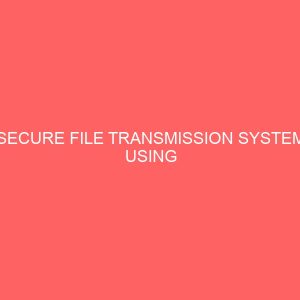Description
This project is to address the problems encountered by the staff of custom and their customers. In view of this problems, the manual process involved in the handling and management of goods in custom office were critically studied and the problems noted. This project went further to treat the different techniques used in implementing the newly designed software. This report describes different techniques and components used when designing and building the data warehouse as well as the graphical user interface developed resulting in the final business intelligence application. Different techniques for optimizing the performance are mentioned as well as main differences and comparisons with a normal relational database design.This work is conducted towards the computerization of the existing system of processing data in order to identify some various problems that is being encountered in mechanical aspect of it and the manual method of data processing in the billing of imported and exported customer goods and thereby recommending first class solution to the problem of information system in the organization. This theory also compares the existing system with the new system which is exact and a faster way of processing data and the problem that is faced by customers when they are clearing their goods from the wharf. This theory includes with the implementation, programming, test run, change over the process of the new system. The software is designed using visual basic 6.0 language. This language was chosen as a result of its easy syntax and structure for developing windows based applications.
CHAPTER ONE
1.0 INTRODUCTION
Data warehousing is a term for the theory and techniques used for extracting, transforming and loading data from multiple sources and providing advanced analysis on the resulting information. A common representation of the data within the data warehouse is the multidimensional approach using facts and dimensions which can be designed and implemented by an OLAP solution. The facts correspond to the measurable numerical values of interest in the analysis while the dimensions are used for giving a context to the facts and built up by multiple levels within hierarchies.
Warehouses Management Systems are primarily tactical tools, purchased and used by businesses to satisfy the unique customer demand requirements of their supply chains and distribution channels, when the inventory and workload are larger than can be handled manually, with spreadsheets. Motivation to purchase generally comes from need to support sales growth or improve performance, and occasionally both.
A WMS uses a data base configured to support warehouse operations, containing detail describing a variety of standard warehouse elements including the Individual Stock Keeping Units SKUs that are handled and stored, e.g., weight, dimensions, case pack, Automatic ID labels bar codes, etc., and inventory by location with manufacture date, lot code, etc. SKUs may include basic materials, fabricated parts, assemblies, and industrial and consumer finished goods, etc.;
Warehouse storage locations, e.g., individual location number, picking sequence, type of use picking, reserve storage, etc., type of storage each, case, pallet, location size or capacity, storage restriction flammable, hazardous, high value materials, outdoor, etc., etc.;
Dock doors, e.g., individual number, etc.; and
Expected labor productivity rates by function or activity, e.g., cases picked per manhour, etc.
Daily management functions include
Planning finalizing the daily plan for receiving dock activity, selecting the workload/orders to be processed in the day or shift, this may also be done by the business system, and calculating an estimate of the labor and vehicles required to pick and ship the orders to ensure the staffing is appropriate, and carriers are notified in time to meet the daily requirements.
Organizing sequencing the orders to be picked. Organizing orders for picking can be accomplished in many ways, meeting the needs of the user. The primary objective is to be intentional, and not pick the orders in the sequence in which they were received unless the company wants to pay a carrier make sense for transportation and delivery. The initial way of organizing was called Wave Planning or Wave Picking, with two objectives, a. to minimize need for dock staging space, by having orders arrive at the shipping dock in trailer load sequence, and b. to create an order of flow that will support monitoring the progress through the day and eliminate/reduce last minute requests for overtime or delay of carrier departure, etc.
Staffing assign staff to work functions and areas, by Wave, to minimize staging.
Directing ensuring the documented processes and procedures are embedded in the WMS and are consistently applied, used and appropriate for the nature of the work and service level intentions of the company e.g., International Standards Organization 9000 www.iso.org. This function may also be used to divide individual orders into logical work units and the ability to assign them to separate individuals for performance, consistent throughput requirements and physical layout, e.g., separating individual case picking from each unit picking, and individual pallet load picking, to improve productivity and supporting Control.
Controlling providing milestones for management to monitor progress through the day, providing the opportunity to respond to problems in a timely way, and report data for performance analysis.
Warehouse Management Systems have the capability to partner with staff in performing the detail processes required to handle all of the major and many minor warehouse tasks of receiving, inspection and acceptance, putaway, internal replenishment to picking positions, picking, packing, order assembly on the shipping dock, documentation, and shipping loading onto carrier vehicles; processes including directing and validating each step, capturing and recording all inventory movement and status changes to the data file.
1.1BACKGROUND OF THE STUDY
Warehouse is where goods and commodities are kept for further clearance. Narrowing it to Nigeria Ports Authority, there are many warehouses where imported consignment and goods are stored. This is cleared by carrying the billing papers from post to post, waiting and wasting much time in seeing who is in charge. Goods that takes about two weeks to berth into the country takes another two weeks to get cleared. This makes the importers and the clearing agents to run from port to port, in search of where the goods were kept.
The introduction of computer in warehousing will enable importers know which and where their goods are kept, as it will always be stipulates on the bill of laden papers. Computer is hereby seen as a way of handling, by systematically organizing them, recording or making notations on them, following up with the appropriate action or the like.
1.2STATEMENT OF THE PROBLEM
The processing of billing papers for clearance of goods, with manual method has led to omission of many records that ought to be included. This is caused by inaccuracy of the manual billing process.
Due to the inefficiency in manual billing process, billing papers are carried from post to post, waiting for who is in charge, thereby delaying the goods that suppose to be delivered.
More so, goods are not delivered on time, due to the fact, that goods that takes about two weeks to get into the country, still takes another two weeks to be cleared.
1.3PURPOSE OF STUDY
The purpose of this is study is to
Identify those problems caused by using manual billing clearance
Finding out the effect of this in Nigeria Ports Authority
Create computer awareness
Identify prospects for solution of problems.SIGNIFICANCE OF THE STUDY
This research, base on the problem and prospect of using computer in Nigeria Ports Authority, will help to develop interest towards computer.
The findings of this research will also help the management to increase the income generation of Nigeria Ports Authority and smooth running of the warehouse in general.
1.5SCOPE OF THE STUDY
The researcher will identify all the problems, including the financial constraints of the problems, encounter with the use of manual billing clearance in warehousing.
1.6LIMITATIONS OF THE STUDY
Due to the financial constraints of the researcher and lack of time, the researcher is concentrating the study in only Nigeria Ports Authority Lagos.
DEFINITION OF TERMS
GOOD Goods carried in a ship
TONNAGE A measure of the capacity of a ship 1 ton 100 cubic feet
PORT A place where ship load and unload goods shattered form storms.
VESSEL A ship for transport by water
BILL OF LOADING A list giving details of a ships goods
CONSIGNCE A person or company to whom goods are sent form the counting of export and who receives them.
MANIFEST A list of all goods on the ship
WHARF This is a landing stage built along the shares for loading or unloading vessels.
LABOUR An area of water protected from the open sea by land or walls in which ships can shelter.
BERTH This is a place in the wharf where a ship can be died up or swing at anchor.
PORT OF LOADING A place where ships load goods and leave for the definition.
PORT OF DISCHARGE A place where unload goods from poof of loading.
OCEAN FREIGHT This is an amount charged by the carrier by the carrier for transportation of goods by sea.
VOYAGE A journey by water mostly a long one in a ship.
SHIPPING This is the process of pulling things on in a ship or transportation goods by ship
WAREHOUSE This is a store house
TRASNPORT This is carriage of goods from one place to another
SAILING This is the movement of ship on a sea from one place to another
CUSTOM This are the people that are in charge of checking the vessel if it contains any contraband items and the paper that contains the particulars of the container in the vessels.
ROTATION NUMBER A number allocated by the department of customs and exercise to every ship entering into future use.
COMPUTER This is an electronic machine that accepts data as input, process it using a set of instructions and given out result as output. It also stores information which could be received for future use.
DATA This are raw fact that have not been processed.
DISK It is a storage device that stores data or information.








Reviews
There are no reviews yet.